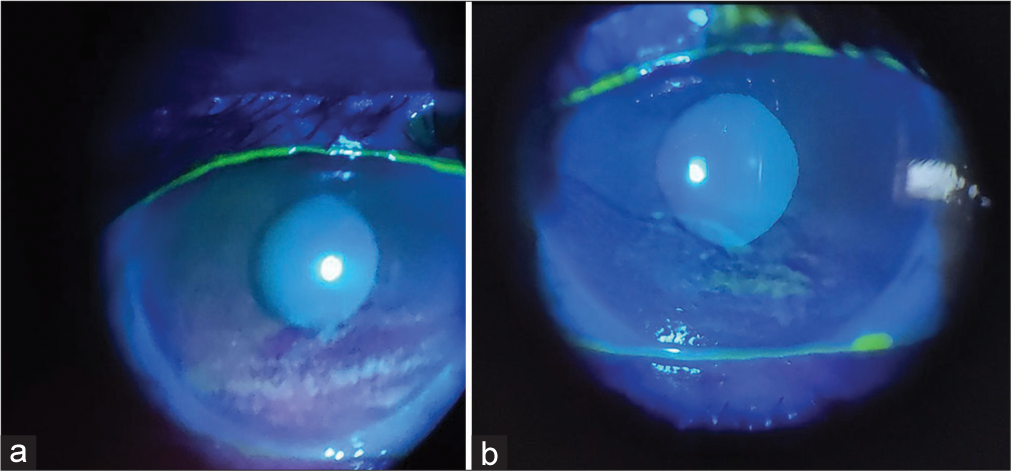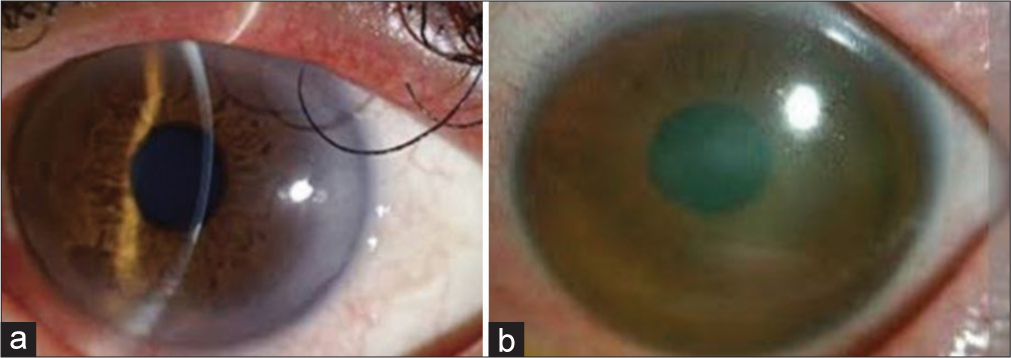Translate this page into:
Shattered vision: Unraveling the impact of the Exide battery blast on ocular health

*Corresponding author: Payal Gonde (Ballamwar), Department of Ophthalmology, Vasan Eye Care Hospital, Secunderabad, Telangana, India. payalgonde@gmail.com
-
Received: ,
Accepted: ,
How to cite this article: Gonde (Ballamwar) P. Shattered vision: Unraveling the impact of the Exide battery blast on ocular health. Lat Am J Ophthalmol 2023:6:14.
Abstract
The patient developed severe symptoms of redness, pain, watering, and intolerance to light following an accidental Exide battery blast explosion. A 45-year-old male was diagnosed with a battery blast related to Grade 1 ocular surface burn. A patient with informed consent was enrolled. He was advised to use topical antibiotics, lubricating agents, topical steroid eye drops, and cycloplegic eye drops. He responded well to treatment and resolved in 3 weeks with complete restoration of vision in both eyes. The number of battery blast injuries to the eyes is increasing as a result of poor equipment and inadequate supervision (incorrectly and excessively charging batteries). It is essential to increase awareness throughout society regarding safe and proper equipment handling to reduce the incidence of preventable blinding trauma. Simple health education and more public awareness should be created to prevent such chemical injuries.
Keywords
Exide battery blast
Ocular surface burn
Chemical injuries
Public awareness
Health education
INTRODUCTION
The Exide battery blast incident has received a lot of attention recently due to the terrible impact that it caused on individuals as well as communities. Ocular injuries have been recognized as one of the most devastating and life-altering consequences of the explosion. Society comes into contact with devices and machinery that convert chemical energy into electrical energy in parallel with technological advancements. The batteries take their place in every part of our daily social life. The majority of batteries include those for watches, motor vehicles, and mobile phone batteries. Exide battery bursts are a highly underestimated reason for severe ocular morbidity. This article covers the nature of the corneal epithelial defect produced by the Exide battery blast, the challenges it presents, and the importance of addressing this problem for those affected with the goal of shedding light on an issue.
CASE REPORT
A 45-year-old male came into the department of ophthalmology of the tertiary eye care center with pain, redness, burning sensation, intolerance to light, and watering from both eyes, following an Exide battery blast. His eyes were affected by the quick release of smoke, flames, and soot particles as a consequence. He was not wearing glasses when the incident happened. His presenting visual acuity was 20/60 and 20/80 in the right eye and the left eye, respectively.
On ocular examination, numerous soot particles became embedded over the cornea, conjunctiva, and lid margins, in addition to circumciliary congestion [Figure 1a and b]. The eyes were cleaned with regular saline wash and then checked again. Bilateral mild periorbital edema was present. Both corneas had central epithelial defects which stained heavily with fluorescein [Figure 2a and b]. There was no limbal ischemia, and it was diagnosed as a Grade 1 ocular surface burn.[1] Using Tonopen, the intraocular pressure was found to be normal. There were no intraocular foreign bodies, and the posterior segment was normal.

- (a) Right eye and (b) left eye showing mild periorbital edema, circumciliary congestion with corneal epithelium defect.

- (a) Right eye and (b) left eye had corneal epithelial defects which stained heavily with fluorescein.
He was instructed to use topical prednisolone 1% eye drops in tapering doses,[2] topical lubricating eye drops 8 times daily, topical moxifloxacin hydrochloride 0.5% eye drops 4 times daily, topical homatropine 2% eye drops 3 times daily, as well as systemic non-steroidal anti-inflammatory drugs for pain relief. Topical steroids were given to prevent inflammation caused by soot particles. Topical antibiotics were given to prevent any secondary infection that may occur. Lubricants helped in faster and better healing of the cornea. The epithelial defect started to heal the next day and was completely healed after 1 week [Figure 3a and b]. With a successful outcome in both eyes, the inflammation was reduced after 3 weeks. (Unaided visual acuity 20/20; clear corneas [Figure 4a and b]).

- (a) Right eye and (b) left eye after 1 week of treatment.

- (a) Right eye and (b) left eye after 3 weeks of treatment.
DISCUSSION
Batteries, especially Exide batteries, contain a variety of materials that, if handled improperly or disposed of in an inappropriate way, could be hazardous. Lead-acid batteries frequently use diluted sulfuric acid as their electrolyte, which is caustic and can be dangerous if it comes into contact with the skin or eyes. Even though lead-acid batteries are typically regarded as safe, there is occasionally a fire risk. The risk of thermal runaway, which could result in a fire hazard, can be raised by overcharging, short-circuiting, or exposing the battery to high temperatures. The risk of battery-related fires can be minimized by adhering to normal charging practices, utilizing the proper charging equipment, and avoiding excessive temperatures.[3]
Battery blasts occur in any type of battery, including Exide batteries, but they are extremely uncommon. If a battery suddenly releases energy, it can result in a battery blast, which is a hazardous and potentially dangerous condition that frequently involves an explosion. It is important to understand the causes and take appropriate safety precautions to minimize the risk. Here are some key points to consider:
Causes of battery blasts[3]
Overcharging: Overcharging is one of the main reasons for battery explosions. Excessive gas build-up can happen inside batteries if they are charged for longer periods or at voltages that are higher than they should be. Pressure can increase to dangerous levels and lead to an explosion if this gas is not properly vented or released.
Short-circuiting: The direct contact of a battery’s positive and negative terminals or the occurrence of a conductive material in the space between them might result in a short circuit. This leads to a sharp increase in current that generates heat and can lead to a battery explosion.
Physical damage: Batteries are exposed to damage from accidents, impacts, and poor handling. The chemical reactions inside the battery may be disrupted, and the conditions for a blast may be created if the battery shell or internal components are disturbed.
In addition, the batteries include an electrolyte that may catch fire as it heats up and takes off once oxygen comes into contact with it. Thus, a combination of mechanical (battery fragments), thermal, and chemical harm could be the mechanism of injury from a battery blast.
Ocular injuries and the impact on victims
The Exide battery explosion’s ocular damage has had an important effect on the victims’ lives. The explosion’s tremendous impact, in addition to flying objects and hazardous chemicals, seriously harmed the eyes. The blast can immediately injure the eye, resulting in fractures, lacerations, and the penetration of foreign objects. When harmful chemicals are released during an explosion, chemical burns to the eyes can follow, causing tissue damage and vision impairment. The blast’s debris may damage the cornea, leading to pain, redness, and reduced vision. The sudden pressure changes and impact from the explosion can cause the retina to detach from the back of the eye, resulting in severe vision loss or blindness if not promptly treated.[4]
Immediate and long-term effects
Ocular injuries from the Exide battery explosion might have devastating immediate consequences. Excruciating pain, swelling, bleeding, and vision impairment are common among victims. Some may require emergency surgical interventions to address the immediate damage to their eyes and prevent further complications. Ocular injuries have an impact that extends far beyond the initial trauma, too. Ocular injuries from the explosion could cause partial or total blindness, which would have a serious negative effect on the victim’s quality of life and ability to go about their daily activities. Anxiety, depression, and a profound sense of loss are just some of the psychological consequences that can result from losing one’s vision or experiencing a severe visual impairment. Ocular victims of injuries might require significant rehabilitation, which may include vision treatment, assistive technology, and adaptive strategies to relearn routine tasks and maintain independence.
Addressing the issue
The Exide battery blast-induced corneal epithelium defects demand urgent attention and appropriate measures to alleviate the suffering of the affected individuals. It is crucial to address this issue from multiple perspectives:
Immediate medical attention: Victims of ocular injuries should seek immediate medical attention from ophthalmologists or eye care specialists. Early detection and intervention may prevent problems and improve the possibility of a full recovery.
Comprehensive eye care: A wide range of treatments, including the use of protective contact lenses, medicinal eye drops, and, in more severe circumstances, surgical procedures such as corneal grafts, may be used to successfully treat ocular injuries.
Rehabilitation and support: To regain visual acuity and respond to any residual visual impairment, individuals may need continued vision therapy and rehabilitation. During the recovery process, support groups and counseling services can also offer crucial emotional support.
A few published case studies from India showed favorable outcomes for timely and appropriate case management. In a case report from India by Narang et al., a mobile blast produced a Grade 1 ocular surface burn involving numerous soot particles over the cornea and conjunctiva and a burned eye.[2] In the study by Ohri et al., similar eye damage from mobile blasts was observed.[4] Duke–Elder mentioned in passing that batteries could catch fire and produce acid burns.[5] Moreover, Minatoya, in a prospective study, presented 62 cases of injury from battery explosions.[6]
This is the case report from India reporting an Exide battery-related ocular injury leading to a corneal epithelial defect that was completely resolved after early treatment and demonstrates the consequences of a battery blast. Battery bursts are caused by faulty battery charging techniques and poor quality. Among the various injuries resulting from this catastrophic event, corneal epithelium defects have emerged as a particularly distressing consequence.
Safety precautions to minimize the risk
The Australian Standards Association has also prepared a draft Public Information Guide to the use of automotive batteries. This guide is intended to be made available to users of batteries and details safety precautions felt necessary by the association for the use of lead-acid batteries.[7]
Proper charging: Follow the manufacturer’s guidelines for charging Exide batteries, including the recommended voltage and charging duration. Avoid overcharging the battery and ensure you use a compatible and properly rated charger. Overcharging and faulty methods of battery charging should be avoided.
Avoid short circuits: Prevent direct contact between the positive and negative terminals of the battery. When handling or storing batteries, ensure they are placed in non-conductive containers or use appropriate insulation materials to prevent accidental short circuits.
Inspect for damage: Regularly inspect batteries for any signs of physical damage, such as cracks, bulges, or leaks. If you notice any damage, discontinue using the battery and consult a professional for inspection or replacement.
Proper storage: Store batteries in a cool, dry place away from direct sunlight and sources of heat. Avoid storing batteries near flammable materials. Proper storage helps maintain the stability of the battery and reduces the risk of thermal runaway.
Follow safety guidelines: When working with batteries, wear appropriate protective gear, such as gloves and eye protection. Follow the safety guidelines provided by Exide and other relevant safety standards to minimize the risk of accidents.
CONCLUSION
The Exide battery blast-related ocular injuries have left a lasting impact on the victims and their families. To grasp the scope of this tragedy, one must be aware of the hazards involved as well as the immediate and long-term effects of these injuries. Understanding the nature of these defects and the challenges they pose is essential for both medical professionals and affected individuals. By providing prompt and comprehensive medical care and raising awareness, we, as an ophthalmologist, can strive toward easing the burden on those affected and ensuring accountability for such devastating incidents. Battery blast hazards can be reduced using proper charging techniques, preventing short circuits, inspecting for damage, and storing batteries correctly.
Beware and safeguard your sight before the spark ignites: Protect your vision by avoiding an Exide battery blast ocular injury.
Declaration of patient consent
The authors certify that they have obtained all appropriate patient consent.
Conflicts of interest
There are no conflicts of interest.
Use of artificial intelligence (AI)-assisted technology for manuscript preparation
The author confirms that there was no use of artificial intelligence (AI)-assisted technology for assisting in the writing or editing of the manuscript and no images were manipulated using AI.
Financial support and sponsorship
Nil.
References
- A new classification of ocular surface burns. Br J Ophthalmol. 2001;85:1379-83.
- [CrossRef] [PubMed] [Google Scholar]
- Ocular surface burn secondary to smart phone battery blast. Indian J Ophthalmol. 2017;65:326.
- [CrossRef] [PubMed] [Google Scholar]
- Injury following blast of mobile phone battery. Int Ann Med. 2017;1:265.
- [CrossRef] [Google Scholar]
- System of ophthalmology In: Vol. 14, Injuries. Part 1, Mechanical injuries. Part 2, Non-mechanical injuries, Vol. 2. London: Henry Kimpton; 1972.
- [Google Scholar]
- Eye injuries from exploding car batteries. Arch Ophthalmol. 1978;96:477-81.
- [CrossRef] [PubMed] [Google Scholar]
- Lead-acid starter batteries In: Australian standard. Sydney, Australia: Standards Association of Australia; 1980.
- [Google Scholar]







